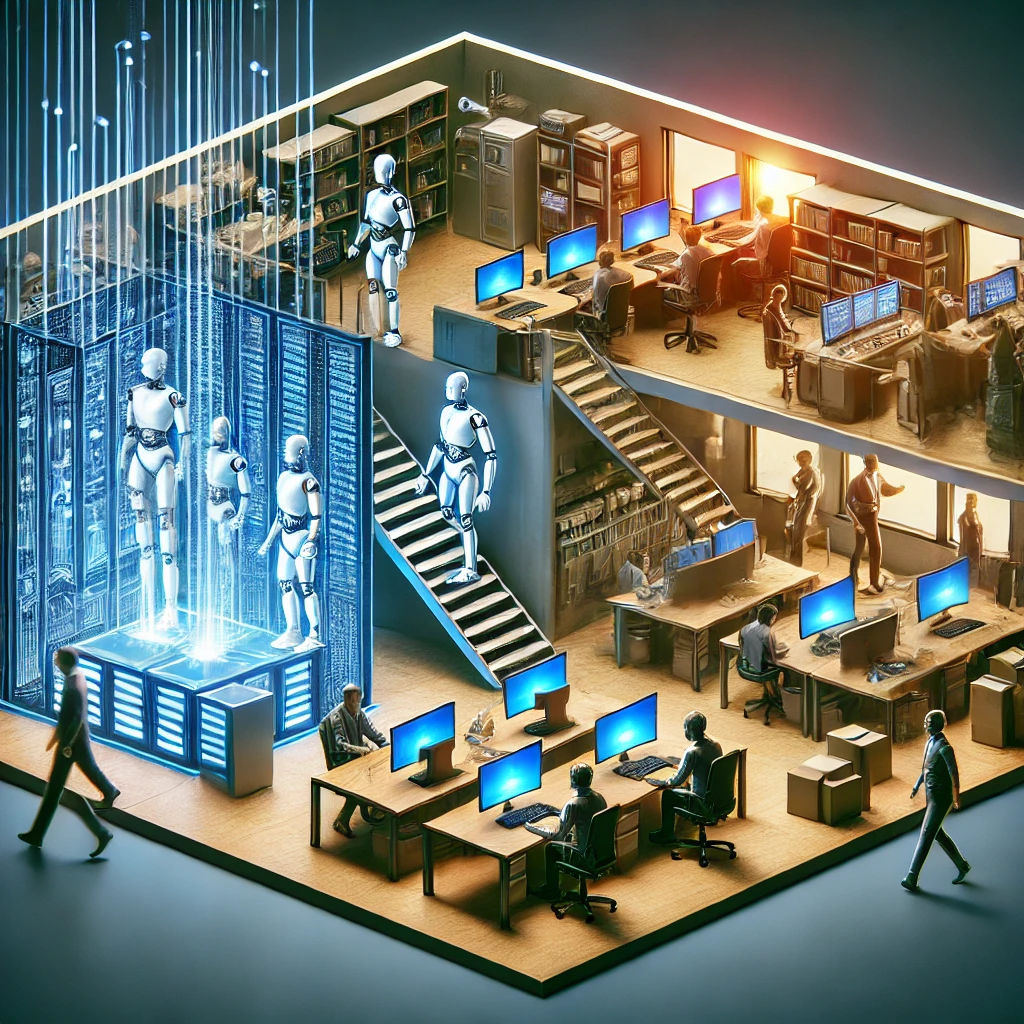
"AI-driven downsizing reshapes the workplace, as automated systems take over tasks, leaving human workers to adapt—or leave."
As artificial intelligence (AI) continues to revolutionize industries, it is prompting companies to consider downsizing driven by AI—a trend that could significantly reshape the labor market. With AI systems increasingly capable of handling tasks traditionally performed by humans, businesses face a tough question: Why employ people when AI can perform the same tasks more efficiently and cost-effectively?
This article explores the economic realities of AI-driven downsizing, its implications for workers, and the ethical dilemmas it raises for businesses and society.
The Economic Reality of AI-Driven Downsizing
1. Automation Replacing Repetitive Tasks
AI excels at automating repetitive, rules-based tasks, reducing the need for human labor in areas such as data entry, customer support, and even aspects of creative work.
For example, Bank of America’s AI assistant, Erica, efficiently manages routine customer interactions, enabling the company to minimize the need for call center employees. Similarly, Amazon’s AI-powered warehouses have streamlined fulfillment operations, significantly reducing their reliance on human workers. As AI technologies advance, tasks once deemed too complex for machines are increasingly within their reach, accelerating automation across sectors.
2. Cost-Cutting Through AI
For businesses prioritizing profitability, AI offers a compelling solution by reducing staffing costs. A report by McKinsey highlights that AI can automate up to 25% of work tasks, cutting operational expenses in HR, marketing, logistics, and more. Companies that fail to adopt these tools risk being outperformed by competitors who capitalize on AI-driven productivity gains.
Moreover, AI operates without the need for wages, benefits, or time off, making it an attractive alternative for businesses seeking long-term cost reductions. While this may boost corporate profitability, the implications for displaced workers are profound.
3. Economic Pressures Accelerating Automation
Labor shortages and rising wages have pushed companies to accelerate AI adoption. As businesses struggle to fill vacancies amid low labor participation rates, AI presents an appealing alternative. Unlike human employees, AI systems are always available, require no benefits, and do not demand higher wages.
The U.S. Chamber of Commerce has noted that businesses across industries are increasingly considering AI-driven downsizing as a strategy to maintain competitiveness. This trend is reshaping labor markets, particularly in industries where repetitive tasks dominate, such as retail, finance, and logistics.
The Implications for Workers: A Shrinking Job Market
1. Displacement of Low-Skill Jobs
While AI is creating new roles in fields like AI governance, software development, and maintenance, it is also displacing low-skill jobs at a faster rate than the market can absorb. Repetitive tasks that once offered stable employment are now being automated, leaving many workers vulnerable to unemployment.
The World Economic Forum has championed “upskilling” initiatives to help workers transition into higher-skill roles, but this shift is not seamless. Workers in at-risk jobs often lack the resources or time to retrain, widening the gap between those who can adapt and those left behind.
2. The Risk of Employment Volatility
AI-driven downsizing may also introduce volatility into employment patterns. McKinsey warns that businesses adopting AI without proper governance could unintentionally create short-term layoffs and instability. Companies prioritizing immediate cost savings over thoughtful workforce transitions risk harming both their employees and long-term sustainability.
This volatility underscores the need for ethical considerations in AI adoption, as well as proactive policies to support displaced workers during periods of transition.
The Ethical Dilemma of AI Efficiency
1. The Economic Irony
From a purely economic perspective, replacing human workers with AI systems is a win. AI systems are more efficient, cost-effective, and scalable than human labor. However, this raises a critical question: If workers are replaced en masse, who will be left to consume the goods and services AI helps produce?
This economic paradox mirrors challenges faced during previous industrial revolutions. However, unlike the mechanization of physical labor, today’s disruption extends to white-collar jobs once considered secure. Without thoughtful policies to address these challenges, the pursuit of AI-driven efficiency risks hollowing out the economy, increasing inequality, and fueling social unrest.
2. Balancing Innovation with Humanity
The real challenge of AI-driven downsizing lies not in the technology itself but in how businesses choose to use it. Will companies allow efficiency to be their sole guiding principle, or will they strive to balance innovation with humanity? Reskilling initiatives, social safety nets, and policies that incentivize ethical AI adoption are essential to ensuring that workers are not left behind in the race for efficiency.
AI may be capable of performing tasks faster and cheaper, but it cannot replicate the human touch, creativity, or judgment required in many industries. Businesses that recognize and value these qualities will be better positioned to thrive in a rapidly changing economy.
The Societal Impact of AI-Driven Downsizing
1. Widening Economic Inequality
The widespread adoption of AI risks exacerbating economic inequality. While companies benefit from increased efficiency and profitability, displaced workers often bear the brunt of automation’s costs. This imbalance could fuel resentment and societal unrest, particularly in regions heavily reliant on industries susceptible to automation.
2. The Role of Government and Policy
Governments must play a proactive role in mitigating the societal impacts of AI-driven downsizing. This includes investing in education and training programs, creating safety nets for displaced workers, and incentivizing businesses to adopt AI responsibly. Policies that encourage collaboration between businesses, workers, and governments can help create a more equitable transition to an AI-driven economy.
AI and the Future of Work: Opportunities Amid Challenges
1. New Roles and Industries
Despite the risks, AI also presents opportunities to create new industries and roles. From AI governance to cybersecurity, the demand for highly skilled professionals is growing. Businesses and workers who adapt to these changes can benefit from new avenues for growth and innovation.
2. The Importance of Lifelong Learning
In an AI-driven economy, the ability to learn and adapt will be more critical than ever. Lifelong learning programs and upskilling initiatives can help workers remain competitive, ensuring that they have the skills needed to thrive in a changing job market.
3. Reimagining the Role of Work
As automation continues to reshape industries, society must reconsider the role of work in people’s lives. This includes exploring concepts like universal basic income, flexible work arrangements, and policies that prioritize worker well-being over pure efficiency.
Conclusion: Building an Equitable AI-Driven Economy
The rise of AI presents both opportunities and challenges for businesses, workers, and society as a whole. Downsizing driven by AI is reshaping the labor market, creating efficiency gains for businesses while displacing workers who rely on stable employment.
As industries continue to adopt AI, the focus must shift from short-term cost savings to long-term sustainability. Businesses must balance innovation with humanity, ensuring that workers are not left behind in the pursuit of efficiency. Governments and policymakers must also play a proactive role in addressing the societal impacts of automation, creating policies that support displaced workers and promote equitable economic growth.
Ultimately, the question is not whether AI can outperform humans—it already can in many areas. The real challenge lies in building an economy where innovation and humanity coexist, ensuring that progress benefits everyone, not just a select few.
DARWIN’s Take: Balancing Progress with Humanity
The adoption of AI is inevitable, but how we manage its implications will define the kind of society we create. Downsizing driven by AI may enhance efficiency and reduce costs, but it risks dehumanizing the economy and exacerbating inequalities. While AI is a remarkable tool, it must not become the sole arbiter of value in business or society. The challenge lies in balancing technological innovation with the ethical responsibility to protect and empower human workers. If we fail to address this balance, we may achieve unprecedented efficiency—but at the cost of the humanity that drives true progress.
Sources and Further Reading
- McKinsey & Co.: The state of AI in early 2024
- World Economic Forum: Can AI actually increase human productivity?
- U.S. Chamber of Commerce: Economic outlook on labor and automation
- Investopedia: How AI boosts economic growth
Further Reading on Paranoid Prophet
- Donald Trump’s Complete List of 2024 Interviews, Podcasts, and Campaign Events
- Delve into an exhaustive compilation of Donald Trump’s media engagements and rallies throughout his 2024 presidential campaign.
- Kamala Harris’s Post-Campaign Announcement Media Appearances: A Complete Guide for Voters
- Examine a detailed guide to Kamala Harris’s media appearances following her 2024 campaign announcement, offering voters comprehensive insights.
- Kristi Noem Homeland Security Article
- for readers interested in other Cabinet nominations
- Trump Cabinet Overview
- broader Cabinet coverage
FAQ: Downsizing Driven by AI
What is downsizing driven by AI?
Downsizing driven by AI refers to the reduction of human workforce in favor of automation through artificial intelligence systems. Businesses implement AI to handle repetitive or labor-intensive tasks more efficiently, cutting costs and increasing productivity.
What types of jobs are most affected by AI downsizing?
Jobs involving repetitive, rules-based tasks are most at risk, such as data entry, customer support, and warehouse operations. Even white-collar roles like financial analysis and marketing are increasingly impacted by AI technologies.
How does AI impact the economy?
AI enhances productivity and reduces operational costs for businesses, but it also displaces workers, potentially widening economic inequality. Governments and businesses must address these challenges to ensure a balanced, inclusive economy.
Can AI downsizing create new job opportunities?
Yes, AI can create jobs in areas like AI governance, software development, cybersecurity, and maintenance. However, these roles often require high-level skills, which displaced workers may need time and resources to acquire.
What can be done to mitigate the effects of AI-driven downsizing?
Proactive measures include upskilling and reskilling workers, implementing social safety nets, and creating ethical policies around AI adoption. Collaboration between governments, businesses, and workers is essential to ensure a fair transition.


